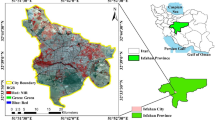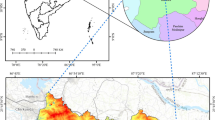Abstract
This study showcases the comparison of ecological quality in Delhi and also predicts the environmental quality in coming future if the anthropogenic activities continue to remain the same. A pilot study was conducted by using the remotely sensed data to develop a Geospatial Ecological Impact Index (GEII), by implementing Analytical Hierarchy Process (AHP) which incorporated vegetation, moisture content, land surface temperature, water bodies, and built-up factors of the study area to examine how much they have impacted the ecology and in what manner. The ecological changes were contrasted between the years 2016 and 2020. It was revealed through this study that the overall ecological quality has decreased over the years with an increase in the mean LST. A simulated map was also developed using the nonlinear modelling technique, i.e. artificial neural network (ANN) to ascertain the future ecological quality for the year 2024. Certainly, this study can help decision makers, urban planners, and researchers in formulating new ways to mitigate and overcome the continuous degradation of ecology.
Access this chapter
Tax calculation will be finalised at checkout
Purchases are for personal use only
Similar content being viewed by others
References
Niyogi D et al (2018) The impact of land cover and land use change on the Indian monsoon region hydroclimate. pp 553–575. https://doi.org/10.1007/978-3-319-67474-2_25
Angel S, Parent J, Civco D (2007) Urban sprawl metrics: An analysis of global urban expansion using GIS. In: American society for photogrammetry and remote sensing—ASPRS annual conference 2007: identifying geospatial solutions, vol 1, pp 22–33
Sinha RK, Sharma A (2006) Landscape level disturbance gradient analysis in Daltonganj south forest division. J Indian Soc Remote Sens 34(3):233–243. https://doi.org/10.1007/BF02990652
Guo H, Zhang B, Bai Y, He X (2017) Ecological environment assessment based on remote sensing in Zhengzhou. In: IOP conference series earth environment science, vol 94(1). https://doi.org/10.1088/1755-1315/94/1/012190
Trivedi RK, Chourasia LP, Singh DK (2006) Application of remote sensing in the study of geo-environmental aspects of Rajghat DAM project. J Indian Soc Remote Sens 34(3):309–317. https://doi.org/10.1007/BF02990659
Tang UW, Wang ZS (2007) Influences of urban forms on traffic-induced noise and air pollution: results from a modelling system. Environ Model Softw 22(12):1750–1764. https://doi.org/10.1016/j.envsoft.2007.02.003
Nikolakopoulos KG, Vaiopoulos DA, Skianis GA (2007) Use of multitemporal remote sensing data for map** the Alfios River network changes from 1977 to 2000. Geocarto Int 22(4):251–271. https://doi.org/10.1080/10106040701204727
Kunwar P, Kachhwaha TS (2003) Spatial distribution of area affected by forest fire in Uttaranchal using remote sensing and GIS techniques. J Indian Soc Remote Sens 31(3):145–148. https://doi.org/10.1007/BF03030821
Dwivedi RS, Sreenivas K, Ramana KV, Sujatha G, Sharma KL (2006) Delineation of lands affected by Tanneries’ Effluents: a remote sensing and GIS approach. J Indian Soc Remote Sens 34(1):95–100. https://doi.org/10.1007/BF02990751
Goyal VC, Jain SK, Pareek N (2005) Water logging and drainage assessment in Ravi-Tawi Irrigation command (J&K) using remote sensing approach. J Indian Soc Remote Sens. 33(1):7–15. https://doi.org/10.1007/BF02989986
Dwivedi RS, Ramana KV, Sreenivas K (2007) Temporal behavior of surface waterlogged areas using spaceborne multispectral multitemporal measurements. J Indian Soc Remote Sens 35(2):173–184. https://doi.org/10.1007/BF02990781
Rout DK, Parida PK, Behera G (2005) Man-made disaster-a case study of NALCO Ash-pond in the Angul district, Orissa using remote sensing and GIS technique. J Indian Soc Remote Sens 33(2):291–295. https://doi.org/10.1007/BF02990048
Kunwar TS, Kachhwaha P, Assessment soil erosion hazard through remote sensing and GIS technique in Kuthlar Gad Sub-watershed, Almora District, Uttar Pradesh, pp 212–215
de Asis AM, Omasa K (2007) Estimation of vegetation parameter for modeling soil erosion using linear spectral mixture analysis of landsat ETM data. ISPRS J Photogram Remote Sens 62(4):309–324. https://doi.org/10.1016/j.isprsjprs.2007.05.013
Das JD, Dutta T, Saraf AK (2007) Remote sensing and GIS application in change detection of the Barak River channel, N.E. India. J Indian Soc Remote Sens 35(4):301–312. https://doi.org/10.1007/BF02990786
Durbude DG, Purandara BK (2005) Assessment of sedimentation in the Linganmakki reservoir using remote sensing. J Indian Soc Remote Sens 33(4):503–509. https://doi.org/10.1007/BF02990735
Rathore DS, Choudhary A, Agarwal PK (2006) Assessment of sedimentation in Harakud reservoir using digital remote sensing technique. J Indian Soc Remote Sens 34(4):377–383. https://doi.org/10.1007/BF02990922
Ochoa-Gaona S, Kampichler C, de Jong BHJ, Hernndez S, Geissen V, Huerta E (2010) A multi- criterion index for the evaluation of local tropical forest conditions in Mexico. For. Ecol. Manage. 260(5):618–627. https://doi.org/10.1016/j.foreco.2010.05.018
Xu H, Wen X, Ding F (2009) Urban expansion and heat island dynamics in the Quanzhou region, China. IEEE J Sel Top Appl Earth Obs Remote Sens 2(2):74–79. https://doi.org/10.1109/JSTARS.2009.2023088
Chen A, Sun R, Chen L Studies on urban heat island from a landscape pattern view: a review. Shengtai Xuebao/Acta Ecol Sin 32(14):4553–4565. https://doi.org/10.5846/stxb201106280965
Wen XL, Xu H-Q, Remote sensing analysis of impact of Fuzhou city expansion on water quality of Lower Minjiang River, China. Sci Geogr Sin 30(4):624–629
Xu H (2013) “Remote sensing evaluation index of regional ecological environment change. Chinese Environ Sci
Somvanshi SS, Kunwar P, Tomar S, Singh M (2018) Comparative statistical analysis of the quality of image enhancement techniques. Int J. Image Data Fusion 9(2):131–151. https://doi.org/10.1080/19479832.2017.1355336
Zhang Z, He G (2013) Generation of Landsat surface temperature product for China, 2000–2010. Int J Remote Sens 34(20):7369–7375. https://doi.org/10.1080/01431161.2013.820368
Weng Q, Fu P (2014) Modeling annual parameters of clear-sky land surface temperature variations and evaluating the impact of cloud cover using time series of Landsat TIR data. Remote Sens Environ 140:267–278. https://doi.org/10.1016/j.rse.2013.09.002
Weng Q, Fu P, Gao F (2014) Generating daily land surface temperature at Landsat resolution by fusing Landsat and MODIS data. Remote Sens Environ. 145:55–67. https://doi.org/10.1016/j.rse.2014.02.003
Roy DP et al (2014) Landsat-8: science and product vision for terrestrial global change research. Remote Sens Environ 145:154–172
Huang C, Goward SN, Masek JG, Thomas N, Zhu Z, Vogelmann JE (2010) An automated approach for reconstructing recent forest disturbance history using dense Landsat time series stacks. Remote Sens Environ 114(1):183–198. https://doi.org/10.1016/j.rse.2009.08.017
Girard M-C, Girard C (2003) Processing of remote sensing data. CRC Press Taylor Fr. Gr., p 508
Rogers AS, Kearney MS (2004) Reducing signature variability in unmixing coastal marsh Thematic Mapper scenes using spectral indices. Int J Remote Sens 25(12):2317–2335. https://doi.org/10.1080/01431160310001618103
He C, Shi P, **e D, Zhao Y (2010) Improving the normalized difference built-up index to map urban built-up areas using a semiautomatic segmentation approach. Remote Sens Lett 1(4):213–221. https://doi.org/10.1080/01431161.2010.481681
Zha Y, Gao J, Ni S (2003) Use of normalized difference built-up index in automatically map** urban areas from TM imagery. Int J Remote Sens 24(3):583–594. https://doi.org/10.1080/01431160304987
Sukrisyanti (2007) Evaluasi Indeks Urban Pada Citra Landsat Multitemporal Dalam Ekstraksi Kepadatan Bangunan. J Ris Geol dan Pertamb 17(1):1. https://doi.org/10.14203/risetgeotam2007.v17.153
Ruíz AAB (2015) Measuring vegetation. NASA Earth Observat 3(2):54–67
Zubair S, UlWafa B, Somvanshi SS, Kumari M, Comparative analysis of different satellite based water indices for the assessment of water bodies. In: National conference on recent trends in environmental pollution & disaster risk reduction
Li F, Chang Q, Shen J (2015) Ecological environment of the loess plateau gully areas of remote sensing dynamic monitoring. Taking Shaanxi Province as an example in. Chinese J Appl Ecol 3811–3817
Li H et al Evaluation of the VIIRS and MODIS LST products in an arid area of Northwest China. Remote Sens Environ 142:111–121. https://doi.org/10.1016/j.rse.2013.11.014
Liu F (2012) Retrieval of surface temperature by remote sensing
Saaty TL (1977) A scaling method for priorities in hierarchical structures. J Math Psychol 15(3):234–281. https://doi.org/10.1016/0022-2496(77)90033-5
Saaty TL (2000) Fundamentals of decision making and priority theory with the analytic. p 478
Song HM, Xue L (2016) Dynamic monitoring and analysis of ecological environment in Weinan City, Northwest China based on RSEI model. Chinese J Appl Ecol 27(12):3913–3919. https://doi.org/10.13287/j.1001-9332.201612.024
Eastman JR, IDRISI Taiga: guide to gis and image processing, p 342.
Author information
Authors and Affiliations
Corresponding author
Editor information
Editors and Affiliations
Rights and permissions
Copyright information
© 2021 The Author(s), under exclusive license to Springer Nature Singapore Pte Ltd.
About this paper
Cite this paper
Zubair, S., Jain, S.K., Somvanshi, S. (2021). Comparative Analysis and Prediction of Ecological Quality of Delhi. In: Al Khaddar, R., Kaushika, N.D., Singh, S., Tomar, R.K. (eds) Advances in Energy and Environment . Lecture Notes in Civil Engineering, vol 142. Springer, Singapore. https://doi.org/10.1007/978-981-33-6695-4_16
Download citation
DOI: https://doi.org/10.1007/978-981-33-6695-4_16
Published:
Publisher Name: Springer, Singapore
Print ISBN: 978-981-33-6694-7
Online ISBN: 978-981-33-6695-4
eBook Packages: EngineeringEngineering (R0)




